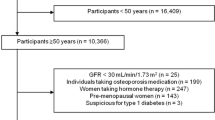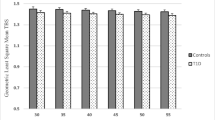Abstract
Summary
Here we report that abnormal brain white matter and, to a lesser extent, albuminuria are associated with reduced bone mineral density in the hip, spine, and total body in men and women. These findings may explain the increased hip fracture risk reported in some studies in association with microvascular disorders.
Introduction
Markers of microvascular disease have been individually associated with increased risk of osteoporotic fractures in some studies. Here, we examine whether these markers are associated with reduced bone mineral density (BMD) individually and together.
Methods
BMD testing using dual x-ray absorptiometry of the hip, lumbar spine, and total body was performed in 1473 participants from the Cardiovascular Health Study (mean age ~ 78 years): 1215 were assessed for urinary albumin-creatinine ratio, 944 for abnormal white matter disease (AWMD) by brain MRI, and 541 for retinal vascular disease with fundus photographs. Linear regression models were used to evaluate the cross-sectional association of each marker with BMD accounting for potentially confounding factors.
Results
AWMD was associated with lower hip, spine, and total body BMD in women (β −3.08 to −4.53; p < 0.01 for all) and lower hip and total body BMD in men (β −2.90 to −4.24; p = 0.01–0.03). Albuminuria was associated with lower hip (β −3.37; p = .05) and total body (β −3.21; p = .02) BMD in men, but not in women. The associations of AWMD and albuminuria with BMD persisted with mutual adjustment and appeared to be additive to each other. Retinal vascular disease was not associated with BMD in men or women.
Conclusion
AWMD and, to a lesser extent, albuminuria were independently associated with lower BMD, suggesting that microvascular disease may play a role in the pathogenesis of reduced BMD. These findings need to be confirmed by longitudinal studies.
Similar content being viewed by others
References
Tankò LB, Bagger YZ, Christiansen C (2003) Low bone mineral density in the hip as a marker of advanced atherosclerosis in elderly women. Calcif Tissue Int 73(1):15–20
Bagger YZ, Tankó LB, Alexandersen P, Qin G, Christiansen C, Prospective Epidemiological Risk Factors Study Group (2006) Radiographic measure of aorta calcification is a site-specific predictor of bone loss and fracture risk at the hip. J Intern Med 259(6):598–605
Lampropoulos CE, Papaioannou I, D’Cruz DP (2012) Osteoporosis—a risk factor for cardiovascular disease? Nat Rev Rheumatol 8(10):587–598
Evrard S, Delanaye P, Kamel S, Cristol JP, Cavalier E, SFBC/SN joined working group on vascular calcifications (2015) Vascular calcification: from pathophysiology to biomarkers. Clin Chim Acta 438:401–414
Sobieszczańska M, Jonkisz J, Tabin M, Laszki-Szcząchor K (2013) Osteoporosis: genetic determinants and relationship with cardiovascular disease. Adv Clin Exp Med 22(1):119–124
Barzilay JI, Gao P, Clase CM, Mente A, Mann JF, Sleight P, Yusuf S, Teo KK, OnTARGET/TRANSCEND Investigators (2013) Albuminuria and rapid loss of GFR and risk of new hip and pelvic fractures. Clin J Am Soc Nephrol 8(2):233–240
Barzilay JI, Bůžková P, Chen Z, de Boer IH, Carbone L, Rassouli NN, Fink HA, Robbins JA (2013) Albuminuria is associated with hip fracture risk in older adults: the cardiovascular health study. Osteoporos Int 24(12):2993–3000
Bůžková P, Barzilay JI, Fink HA, Robbins JA, Cauley JA, Fitzpatrick AL (2014) Ratio of urine albumin to creatinine attenuates the association of dementia with hip fracture risk. J Clin Endocrinol Metab 99(11):4116–4123
Jørgensen L, Jenssen T, Ahmed L, Bjørnerem A, Joakimsen R, Jacobsen BK (2007) Albuminuria and risk of nonvertebral fractures. Arch Intern Med 167(13):1379–1385
Ivers RQ, Cumming RG, Mitchell P, Peduto AJ, Blue Mountains Eye Study (2001) Diabetes and risk of fracture: the Blue Mountains eye study. Diabetes Care 24(7):1198–1203
Daya NR, Voskertchian A, Schneider AL, Ballew S, McAdams DeMarco M, Coresh J, Appel LJ, Selvin E, Grams ME (2016) Kidney function and fracture risk: the atherosclerosis risk in communities (ARIC) study. Am J Kidney Dis 67(2):218–226
Delaisse JM (2014) The reversal phase of the bone-remodeling cycle: cellular prerequisites for coupling resorption and formation. Bonekey Rep 3:561. doi:10.1038/bonekey.2014.56 eCollection 2014
Lafage-Proust MH, Roche B, Langer M, Cleret D, Vanden Bossche A, Olivier T (2015) Vico L (2015) assessment of bone vascularization and its role in bone remodeling. Bonekey Rep 4:662. doi:10.1038/bonekey.2015.29 eCollection 2015
Kusumbe AP, Ramasamy SK, Adams RH (2014) Coupling of angiogenesis and osteogenesis by a specific vessel subtype in bone. Nature 507(7492):323–328
Burkhardt R, Kettner G, Böhm W, Schmidmeier M, Schlag R, Frisch B, Mallmann B, Eisenmenger W, Gilg T (1987) Changes in trabecular bone, hematopoiesis and bone marrow vessels in aplastic anemia, primary osteoporosis, and old age: a comparative histomorphometric study. Bone 8(3):157–164
Wang YX, Griffith JF, Kwok AW, Leung JC, Yeung DK, Ahuja AT, Leung PC (2009) Reduced bone perfusion in proximal femur of subjects with decreased bone mineral density preferentially affects the femoral neck. Bone 45(4):711–715
Ma HT, Lv H, Griffith JF, Yuan J, Leung PC (2013) Bone marrow perfusion of proximal femur varied with BMD—a longitudinal study by DCE-MRI. Conf Proc IEEE Eng Med Biol Soc 2013:2607–2610
Cauley JA, El-Hajj Fuleihan G, Arabi A, Fujiwara S, Ragi-Eis S, Calderon A, Chionh SB, Chen Z, Curtis JR, Danielson ME, Hanley DA, Kroger H, Kung AW, Lesnyak O, Nieves J, Pluskiewicz W, El Rassi R, Silverman S, Schott AM, Rizzoli R, Luckey M, FRAX(®) Position Conference Members (2011) Official positions for FRAX® clinical regarding international differences from joint official positions development conference of the International Society for Clinical Densitometry and International Osteoporosis Foundation on FRAX®. J Clin Densitom 14(3):240–262
Fried LP, Borhani NO, Enright P, Furberg CD, Gardin JM, Kronmal RA, Kuller LH, Manolio TA, Mittelmark MB, Newman A, et al. (1991) The cardiovascular health study: design and rationale. Ann Epidemiol 1(3):263–276
Robbins J, Hirsch C, Whitmer R, Cauley J, Harris T (2001) The association of bone mineral density and depression in an older population. J Am Geriatr Soc 49:732–736
Jovanovich A, Bùžková P, Chonchol M, Robbins J, Fink HA, de Boer IH, Kestenbaum B, Katz R, Carbone L, Lee J, Laughlin GA, Mukamal KJ, Fried LF, Shlipak MG, Ix JH (2013) Fibroblast growth factor 23, bone mineral density, and risk of hip fracture among older adults: the cardiovascular health study. J Clin Endocrinol Metab 98(8):3323–3331
Longstreth WT Jr, Bernick C, Manolio TA, Bryan N, Jungreis CA, Price TR (1998) Lacunar infarcts defined by magnetic resonance imaging of 3660 elderly people: the cardiovascular health study. Arch Neurol 55(9):1217–1225
Kuller LH, Longstreth WT Jr, Arnold AM, Bernick C, Bryan RN, Beauchamp NJ Jr, Cardiovascular Health Study Collaborative Research Group (2004) White matter hyperintensity on cranial magnetic resonance imaging: a predictor of stroke. Stroke 35(8):1821–1825
Baker ML, Marino Larsen EK, Kuller LH, et al. (2007) Retinal microvascular signs, cognitive function, and dementia in older persons: the cardiovascular health study. Stroke 38(7):2041–2047
Hubbard LD, Brothers RJ, King WN, Clegg LX, Klein R, Cooper LS, Sharrett AR, Davis MD, Cai J, Atherosclerosis Risk in Communities Study Group (1999) Methods for evaluation of retinal microvascular abnormalities associated with hypertension/sclerosis in the atherosclerosis risk in communities study. Ophthalmology 106:2269–2280
R Development Core Team (2009) R: a language and environment for statistical computing. R Foundation for Statistical Computing, Vienna ISBN 3-900051-07-0. http://www.R-project.org
Wardlaw JM, Valdés Hernández MC, Muñoz-Maniega S (2015) What are white matter hyperintensities made of? Relevance to vascular cognitive impairment. J Am Heart Assoc 4:e001140. doi:10.1161/JAHA.114.001140
Young VG, Halliday GM, Kril JJ (2008) Neuropathologic correlates of white matter hyperintensities. Neurology 71(11):804–811
Simpson JE, Hosny O, Wharton SB, Heath PR, Holden H, Fernando MS, Matthews F, Forster G, O’Brien JT, Barber R, Kalaria RN, Brayne C, Shaw PJ, Lewis CE, Ince PG, Medical Research Council Cognitive Function and Ageing Study Neuropathology Group (2009) Microarray RNA expression analysis of cerebral white matter lesions reveals changes in multiple functional pathways. Stroke 40(2):369–375
Liu YJ, Zhang L, Papasian CJ, Deng HW (2014) Genome-wide association studies for osteoporosis: a 2013 update. J Bone Metab 21(2):99–116
Seitz DP, Adunuri N, Gill SS, Rochon PA (2011) Prevalence of dementia and cognitive impairment among older adults with hip fractures. J Am Med Dir Assoc 12(8):556–564
Debette S, Markus HS (2010) The clinical importance of white matter hyperintensities on brain magnetic resonance imaging: systemic review and meta-analysis. BMJ 341:c3666. doi:10.1136/bmj.c3666
Barzilay JI, Peterson D, Cushman M, Heckbert SR, Cao JJ, Blaum C, Tracy RP, Klein R, Herrington DM (2004) The relationship of cardiovascular risk factors to microalbuminuria in older adults with or without diabetes mellitus or hypertension: the cardiovascular health study. Am J Kidney Dis 44(1):25–34
Santillan A, Nacarino V, Greenberg E, Riina HA, Gobin YP, Patsalides A (2012) Vascular anatomy of the spinal cord. J Neurointerv Surg 4:67–74
Acknowledgments
This research was supported by contracts HHSN268201200036C, HHSN268200800007C, N01HC55222, N01HC85079, N01HC85080, N01HC85081, N01HC85082, N01HC85083, N01HC85086, and grant U01HL080295 from the National Heart, Lung, and Blood Institute (NHLBI), with additional contribution from the National Institute of Neurological Disorders and Stroke (NINDS). Additional support was provided by R01AG023629 from the National Institute on Aging (NIA). A full list of principal CHS investigators and institutions can be found at CHS-NHLBI.org.
The content is solely the responsibility of the authors and does not necessarily represent the official views of the National Institutes of Health.
Author information
Authors and Affiliations
Corresponding author
Ethics declarations
All participants gave informed consent upon study entry. Institutional review board approval was received at all four clinical sites.
Conflicts of interest
None.
Electronic supplementary material
ESM 1
(DOCX 43 kb)
Rights and permissions
About this article
Cite this article
Barzilay, J.I., Bůžková, P., Fink, H.A. et al. Systemic markers of microvascular disease and bone mineral density in older adults. Osteoporos Int 27, 3217–3225 (2016). https://doi.org/10.1007/s00198-016-3649-9
Received:
Accepted:
Published:
Issue Date:
DOI: https://doi.org/10.1007/s00198-016-3649-9




